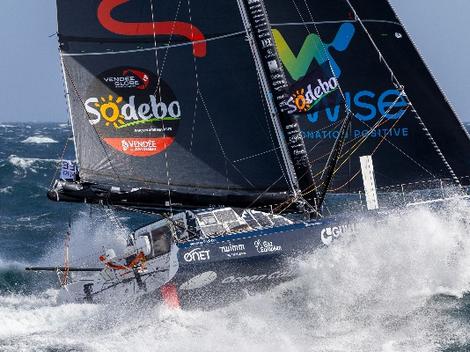Approaching the Cape of Good Hope, the skippers of the Vendée Globe will cross an invisible boundary, marking a decisive turning point in their adventure. This passage symbolizes a radical transformation in the navigation conditions, heralding entry into one of the most feared and fascinating chapters of the race: the Southern Oceans. Vast, isolated, and inhospitable, these ocean expanses challenge sailors with their brutality, while also offering moments of breathtaking beauty. Let’s dive into the dangers and wonders of this unique territory.
Extreme weather conditions and relentless currents
Sailing in the Southern Oceans means confronting legendary climatic violence. Here, depressions follow one another relentlessly, generating powerful winds and waves that can reach the size of a building. This dynamic is exacerbated by the Antarctic Circumpolar Current, a vast ocean river sweeping the waters around Antarctica, making conditions even more challenging.
But beyond the height of the waves, it’s their incessant variations that complicate navigation. Multiple swell trains, created by distant storms, combine with locally generated waves from the winds (the « wind sea »), creating unpredictable aquatic chaos. Every moment becomes a battle against merciless natural forces. Armel Le Cléac’h, before the start of the 2016 Vendée Globe, illustrated this brutal contrast: « We leave pleasant sea conditions, under the sun, with a nice wind where the boat isn’t too tossed around. It’s warm on board, and the water temperature is good as well. Then, in a few hours, we go to winter conditions, even though it’s summer in the Southern Oceans. »
Unexpected dangers: freezing temperatures and invisible obstacles
In addition to the winds and waves, skippers must contend with extremely cold water temperatures. These icy waters increase the risk of hypothermia, and for sailors constantly drenched by spray and submerged by waves, maintaining a stable body temperature is a daily challenge. A simple fall overboard or a mechanical problem can quickly turn into a disaster.
The dangers don’t end there. Skippers also need to avoid UFOs (Unidentified Floating Objects), such as logs, containers, or other debris carried by the currents, which can severely damage the boats. Even worse, icebergs, sometimes drifting just below the surface, pose an invisible threat. At night, these dangers become even more formidable, requiring heightened vigilance. Loïck Peyron perfectly captured this duality between fear and fascination: « It’s violent, but it’s beautiful, in an astonishing purity. […] Icebergs add an extra layer of fascination. » Although the organization has defined an exclusion zone to ensure skippers’ safety due to the high presence of icebergs, the risk of an iceberg drifting outside this zone crossing their path remains very real.
Alone in the world: solitude and fatigue of vast expanses
The Southern Oceans are often described as « the largest maritime desert. » Far from commercial routes and fishing areas, these endless water expanses plunge skippers into total isolation. François Gabart, commenting on the 2020 Vendée Globe, said: « It’s not easy to sail in those places. There’s no one, or very few people. […] In the Southern Oceans, there’s very little maritime traffic and fishing, only a few uninhabited islands. »
This solitude is amplified by fatigue. After several weeks of racing, skippers accumulate chronic sleep deprivation, making every decision more difficult and every maneuver more perilous. Raphaël Dinelli explained: « We can have huge cold spells that last 12 to 24 hours. But we don’t have viruses because these are untouched areas. » This purity contrasts with the constant stress and the struggle to stay on course in extreme conditions. In case of a mishap, this isolation becomes critical. Without immediate rescue or nearby ships, sailors can only rely on their resourcefulness and endurance to survive.
An immaculate and fascinating nature
While these icy and isolated waters may be frightening, they also captivate. The Southern Oceans offer a natural spectacle of unparalleled beauty. Seabirds like albatrosses, capable of flying for months without landing, or majestic whales, cross the skippers’ paths, reminding them that life persists even in these inhospitable regions. Loïck Peyron, deeply impressed by this exceptional nature, described it: « It’s the greatest maritime desert. A unique place. […] Not least because we’re accompanied by birds that never touch land, or almost never. And this swell, of which we know the waves sometimes travel around the world without touching land. »
When the sky clears, the colors and the light become almost unreal. Sometimes, distant lands appear, immaculate, with no trace of human habitation. These suspended moments offer a welcome pause in the constant turmoil of navigation, a reminder of the majesty of our planet.
For the skippers of the Vendée Globe, entering the Southern Oceans is to embrace a mix of fear and fascination. These extreme waters, where man is so small in the face of nature’s vastness, are the stage for a constant struggle for survival, but also for profound awe before a raw and untouched beauty.
Navigators find there an ultimate test, both physical and mental. But for those who pass this stage, the reward is priceless: the certainty of having crossed one of the last wild sanctuaries on the planet.
Source: figaronautisme




